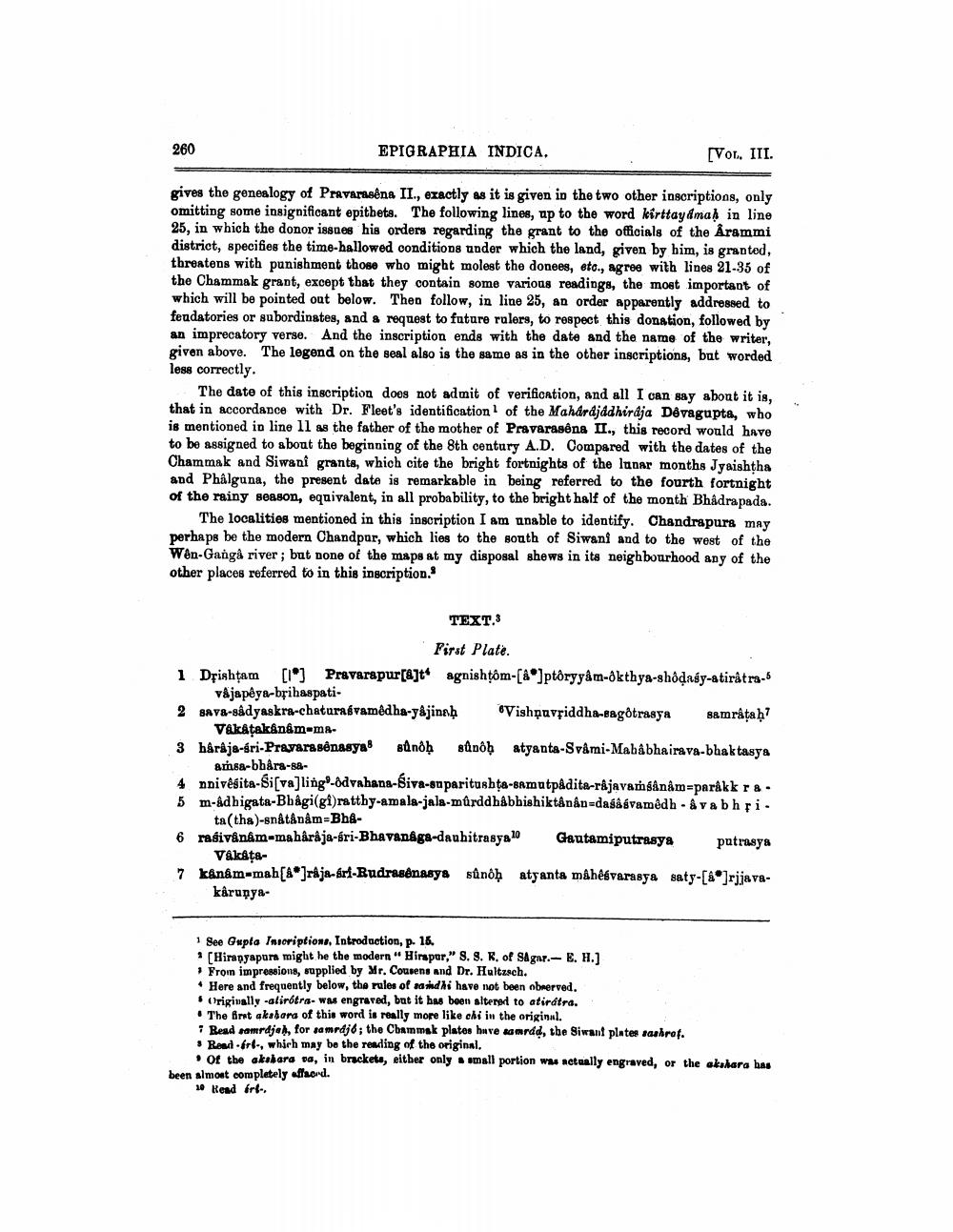________________
260
EPIGRAPHIA INDICA.
[VOL. III.
gives the genealogy of Pravarasena II., exactly as it is given in the two other inscriptions, only omitting some insignificant epithets. The following lines, up to the word karttayamaḥ in line 25, in which the donor issues his orders regarding the grant to the officials of the Arammi district, specifies the time-hallowed conditions under which the land, given by him, is granted, threatens with punishment those who might molest the donees, etc., agree with lines 21-35 of the Chammak grant, except that they contain some various readings, the most important of which will be pointed out below. Then follow, in line 25, an order apparently addressed to feudatories or subordinates, and a request to future rulers, to respect this donation, followed by an imprecatory verse. And the inscription ends with the date and the name of the writer, given above. The legend on the seal also is the same as in the other inscriptions, but worded less correctly.
The date of this inscription does not admit of verification, and all I can say about it is, that in accordance with Dr. Fleet's identification of the Maharajadhiraja Dêvagupta, who is mentioned in line 1l as the father of the mother of Pravaragêna II., this record would have to be assigned to about the beginning of the 8th century A.D. Compared with the dates of the Chammak and Siwani grants, which cite the bright fortnights of the lunar months Jyaishtha and Phâlguna, the present date is remarkable in being referred to the fourth fortnight of the rainy season, equivalent, in all probability, to the bright half of the month Bhådrapads.
The localities mentioned in this inscription I am unable to identify. Chandrapura may perhaps be the modern Chandpur, which lies to the south of Siwani and to the west of the Wên-Gangå river ; but none of the maps at my disposal shews in its neighbourhood any of the other places referred to in this inscription.
TEXT.
First Plate. 1 Dşishtam [1] Prevarapur[a]t agnishtôm-[& Jptôryyâm-ôkthya-shôdasy-atirátra.
vâjapêya-brihaspati2 SAT&-sadyaskra-chaturaśvamedha-y&jink Vishņuvriddha-Bagotrasya samråțah?
Vakatakanam-ma3 haraje-sri-Prayarasónasya Anôh sûnôh atyanta-Svåmi-Mababhairava-bhaktasya
arsa-bhåra-8&4 nnivèsita-Si[valling-Odvahana-Siva-saparitusbta-samutpadita-rajavamsinám=paråkkra. 5 m-adhigata-Bhagi(gi)ratthy-amala-jala-murddhåbbishiktånân-daságvamddh- & vabhi.
ta(tha)-sn&tânâm=Bh6 rasivinâm-maharaja-bri-Bhavanaga-dauhitrasya 10 Gautamiputrasya putrasys
Vâkata7 kanâm-mah[A]rája-sri-Rudrasenasys sûnô► atyanta mahesvarasya saty-[&]rjjava
kârunya
1 See Gupta Inscriptions, Introduction, p. 16.
[Hiranyaporn might be the modern "Hirapor," 8. 9. R. of Sagar.-E. H.) * From impressions, supplied by Mr. Courens and Dr. Hultzsch. * Here and frequently below, the rules of sand i have not been obrerved. • Originally alirbtrs. wms engraved, but it has been altered to atirátra. • The Brot akabara of this word is really more like chi in the original. . Read ramrdjah, for samráj6; the Chammak plates have smrdd, the Siwant plates saalrof.
Reader-, which may be the reading of the original.
• of the akabara va, in brackete, either only small portion was actually engraved, or the akahara has been almost completely ord.
10 Read ért,




